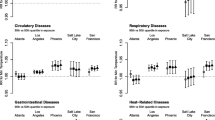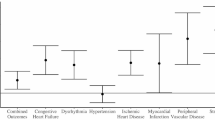Abstract
An increasing number of epidemiological studies are finding statistical evidence that diurnal temperature range (DTR) is positively correlated to human morbidity and mortality despite the lack of clear clinical understanding. We examine a 14-year daily time series of emergency department (ED) admissions to the University of Virginia Medical Center in Charlottesville, Virginia, relative to long-term climate records from the Charlottesville/Albemarle County Airport weather station and the Spatial Synoptic Classification. DTR has a consistent strong positive correlation (r ~ 0.5) with maximum temperature in all months but only a weak, negative correlation (r ~− 0.1) with minimum temperature except in late summer (r ~− 0.4). Warm season DTR is highest on dry air mass days with low dew point temperatures. Cool season DTR is unrelated to morning temperature. Using a distributed lag non-linear model with an emphasis on DTR and its seasonal variation, after stratifying the models by season, we find that ED visits are linked to extreme cold events (cold days and nights) and high DTR in the cold season. In the warm season, ED visits are also linked to high DTR, but these are cool, dry, and pleasant days. The existing confusion regarding interpretation of DTR impacts on health might be rectified through a more careful analysis of the underlying physical factors that drive variations in DTR over the course of a year.







Similar content being viewed by others
References
Anderson BG, Bell ML (2009) Weather-related mortality: how heat, cold, and heat waves affect mortality in the United States. Epidemiology 20:205–213
Barnett AG, Hajat S, Gasparrini A, Rocklöv J (2012) Cold and heat waves in the United States. Environ Res 112:218–224
Braganza K, Karoly DJ, Arblaster JM (2004) Diurnal temperature range as an index of global climate change during the twentieth century. Geophys Res Lett 31(13)
Cheng J, Xu Z, Zhu R, Wang X, Jin L, Song J, Su H (2014) Impact of diurnal temperature range on human health: a systematic review. Int J Biometeorol 58(9):2011–2024
Conti S, Meli P, Minelli G, Solimini R, Toccaceli V, Vichi M et al (2005) Epidemiologic study of mortality during the summer 2003 heat wave in Italy. Environ Res 98:390–399
Davis RE, Enfield KB (2018) Respiratory hospital admissions and weather changes: a retrospective study in Charlottesville, Virginia, USA. Int J Biometeorol 62(6):1015–1025
Davis R, Novicoff W (2018) The impact of heat waves on emergency department admissions in Charlottesville, Virginia, USA. Int J Environ Res Public Health 15(7):1436
Davis RE, Knappenberger PC, Novicoff WM, Michaels PJ (2003) Decadal changes in summer mortality in US cities. Int J Biometeorol 47:166–175
Davis RE, Rossier CE, Enfield KB (2012) The impact of weather on influenza and pneumonia mortality in New York City, 1975–2002: a retrospective study. PLoS One 7(3):e34091
Davis RE, Dougherty E, McArthur C, Huang QS, Baker MG (2016) Cold, dry air is associated with influenza and pneumonia mortality in Auckland, New Zealand. Influenza Other Respir Viruses 10(4):310–313
De Freitas C, Grigorieva E (2015) Role of acclimatization in weather-related human mortality during the transition seasons of autumn and spring in a thermally extreme mid-latitude continental climate. Int J Environ Res Public Health 12(12):14974–14987
Díaz J, García R, López C, Linares C, Tobías A, Prieto L (2005) Mortality impact of extreme winter temperatures. Int J Biometeorol 49(3):179–183
Estela LBL (2018) Biometeorological forecasts for health surveillance and prevention of meteor-tropic effects. Int J Biometeorol 62(5):741–771
Fuhrmann C (2010) The effects of weather and climate on the seasonality of influenza: what we know and what we need to know. Geogr Compass 4(7):718–730
Fuhrmann CM, Sugg MM, Konrad CE, Waller A (2016) Impact of extreme heat events on emergency department visits in North Carolina (2007–2011). J Community Health 41:146–156
Gasparrini A (2011) Distributed lag linear and non-linear models in R: the package dlnm. J Stat Softw 43(8):1
Graudenz GS, Oliveira CH, Tribess A, Landgraf RG, Jancar S, Kalil J (2007) Sudden temperature changes and respiratory symptoms—an experimental approach. Am J Rhinol 21(3):383–387
Gronlund CJ, Zanobetti A, Schwartz JD, Wellenius GA, O’Neill MS (2014) Heat, heat waves, and hospital admissions among the elderly in the United States, 1992–2006. Environ Health Perspect 122:1187–1192
Guo Y, Gasparrini A, Armstrong B, Li S, Tawatsupa B, Tobias A et al (2014) Global variation in the effects of ambient temperature on mortality: a systematic evaluation. Epidemiology 25(6):781
Guo Y, Gasparrini A, Armstrong B, Li S, Tawatsupa B, Tobias A et al (2016) Temperature variability and mortality: a multi-country study. Environ Health Perspect 124(10):1554–1559
Hondula DM, Davis RE (2011) Climatology of winter transition days for the contiguous USA, 1951–2007. Theor Appl Climatol 103(1–2):27–37
Hondula DM, Davis RE, Knight DB, Sitka LJ, Enfield K, Gawtry SB et al (2013) A respiratory alert model for the Shenandoah Valley, Virginia, USA. Int J Biometeorol 57(1):91–105
Hu K, Guo Y, Yang X, Zhong J, Fei F, Chen F et al (2019) Temperature variability and mortality in rural and urban areas in Zhejiang province, China: an application of a spatiotemporal index. Sci Total Environ 647:1044–1051
Huynen MM, Martens P, Schram D, Weijenberg MP, Kunst AE (2001) The impact of heat waves and cold spells on mortality rates in the Dutch population. Environ Health Perspect 109:463–470
Kan H, London SJ, Chen H, Song G, Chen G, Jiang L, Zhao N, Zhang Y, Chen B (2007) Diurnal temperature range and daily mortality in Shanghai, China. Environmental Research 103(3):424–431
Karl TR, Kukla G, Razuvayev VN, Changery MJ, Quayle RG, Heim RR et al (1991) Global warming: evidence for asymmetric diurnal temperature change. Geophys Res Lett 18(12):2253–2256
Lee W, Bell ML, Gasparrini A, Armstrong BG, Sera F, Hwang S et al (2018) Mortality burden of diurnal temperature range and its temporal changes: a multi-country study. Environ Int 110:123–130
Lim YH, Hong YC, Kim H (2012a) Effects of diurnal temperature range on cardiovascular and respiratory hospital admissions in Korea. Sci Total Environ 417:55–60
Lim YH, Park AK, Kim H (2012b) Modifiers of diurnal temperature range and mortality association in six Korean cities. Int J Biometeorol 56(1):33–42
Lim YH, Kim H, Kim JH, Bae S, Hong YC (2013) Effect of diurnal temperature range on cardiovascular markers in the elderly in Seoul, Korea. Int J Biometeorol 57(4):597–603
Lim YH, Reid CE, Mann JK, Jerrett M, Kim H (2015) Diurnal temperature range and short-term mortality in large US communities. Int J Biometeorol 59(9):1311–1319
Linares C, Diaz J, Tobías A, Carmona R, Mirón IJ (2015) Impact of heat and cold waves on circulatory-cause and respiratory-cause mortality in Spain: 1975–2008. Stoch Env Res Risk A 29(8):2037–2046
Mastrangelo G, Fedeli U, Visentin C, Milan G, Fadda E, Spolaore P (2007) Pattern and determinants of hospitalization during heat waves: an ecologic study. BMC Public Health 7:200
Qiu H, Tak-sun Yu I, Tse LA, Tian L, Wang X, Wong TW (2013) Is greater temperature change within a day associated with increased emergency hospital admissions for heart failure? Circ Heart Fail 6(5):930–935
Rocklöv J, Forsberg B (2010) The effect of high ambient temperature on the elderly population in three regions of Sweden. Int J Environ Res. Public Health 14:2607–2619
Sheridan SC (2002) The redevelopment of a weather type classification scheme for North America. Int J Climatol 22(1):51–68
Wang XY, Barnett AG, Yu W, FitzGerald G, Tippett V, Aitken P et al (2012) The impact of heatwaves on mortality and emergency hospital admissions from non-external causes in Brisbane, Australia. Occup Environ Med 69:163–169
Wang MZ, Zheng S, He SL, Li B, Teng HJ, Wang SG (2013) The association between diurnal temperature range and emergency room admissions for cardiovascular, respiratory, digestive and genitourinary disease among the elderly: a time series study. Sci Total Environ 456:370–375
Williams S, Nitschke M, Weinstein P, Pisaniello DL, Parton KA, Bi P (2012) The impact of summer temperatures and heatwaves on mortality and morbidity in Perth, Australia 1994–2008. Environ Int 40:33–38
Wood SN (2017) Generalized additive models: an introduction with R. Chapman and Hall/CRC, New York
Yang J, Zhou M, Li M, Yin P, Wang B, Pilot E et al (2018) Diurnal temperature range in relation to death from stroke in China. Environ Res 164:669–675
Zhang Y, Yu Y, Peng M, Meng R, Hu K, Yu C (2018) Temporal and seasonal variations of mortality burden associated with hourly temperature variability: a nationwide investigation in England and Wales. Environ Int 115:325–333
Acknowledgments
We extend our thanks to Jerry Stenger and Wendy Novicoff (University of Virginia) for their assistance with accessing the climate and health data, respectively, and Scott Sheridan (Kent State University) for running the SSC for Charlottesville. We greatly appreciate the feedback we received from two external reviewers as well as their time and effort in reviewing this research.
Author information
Authors and Affiliations
Corresponding author
Ethics declarations
Statement of informed consent
For this type of study, formal consent is not required as the subjects were de-identified and examined in aggregate.
Additional information
Publisher’s note
Springer Nature remains neutral with regard to jurisdictional claims in published maps and institutional affiliations.
Electronic supplementary material
ESM 1
(DOCX 791 kb)
Rights and permissions
About this article
Cite this article
Davis, R.E., Hondula, D.M. & Sharif, H. Examining the diurnal temperature range enigma: why is human health related to the daily change in temperature?. Int J Biometeorol 64, 397–407 (2020). https://doi.org/10.1007/s00484-019-01825-8
Received:
Revised:
Accepted:
Published:
Issue Date:
DOI: https://doi.org/10.1007/s00484-019-01825-8




